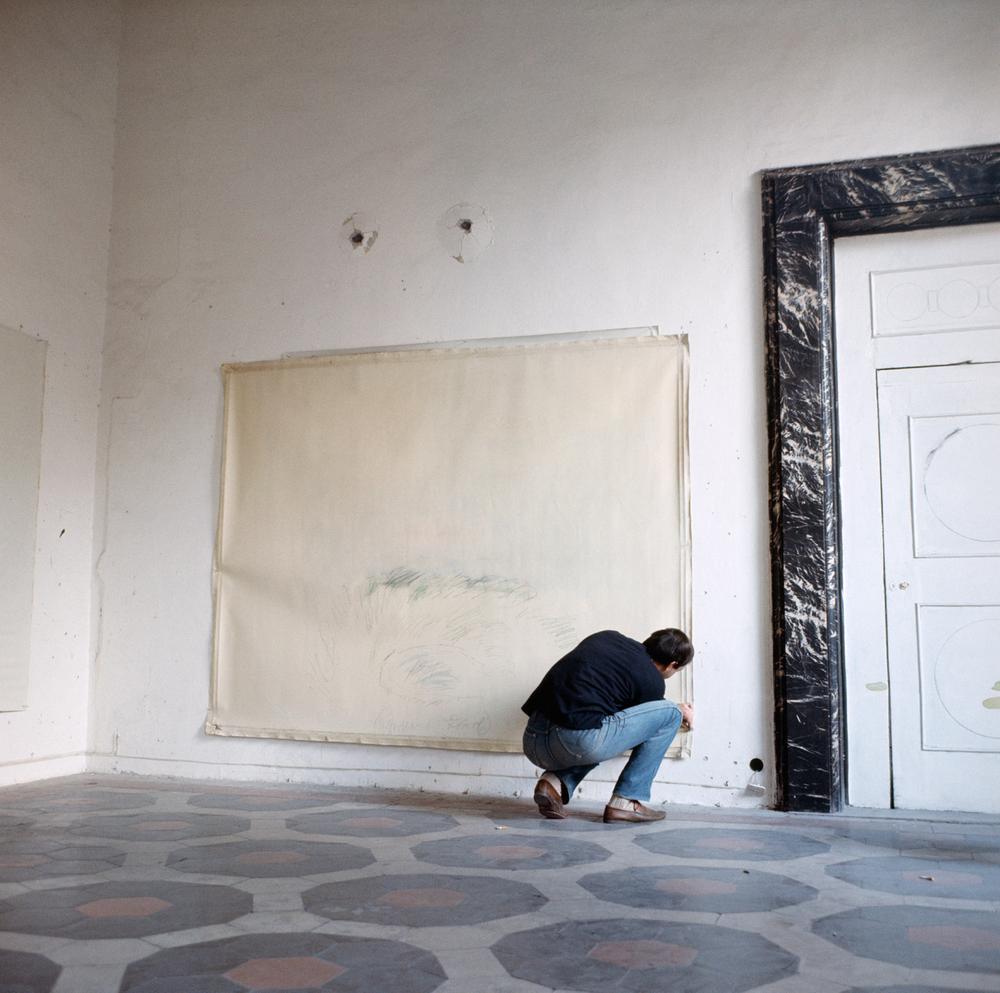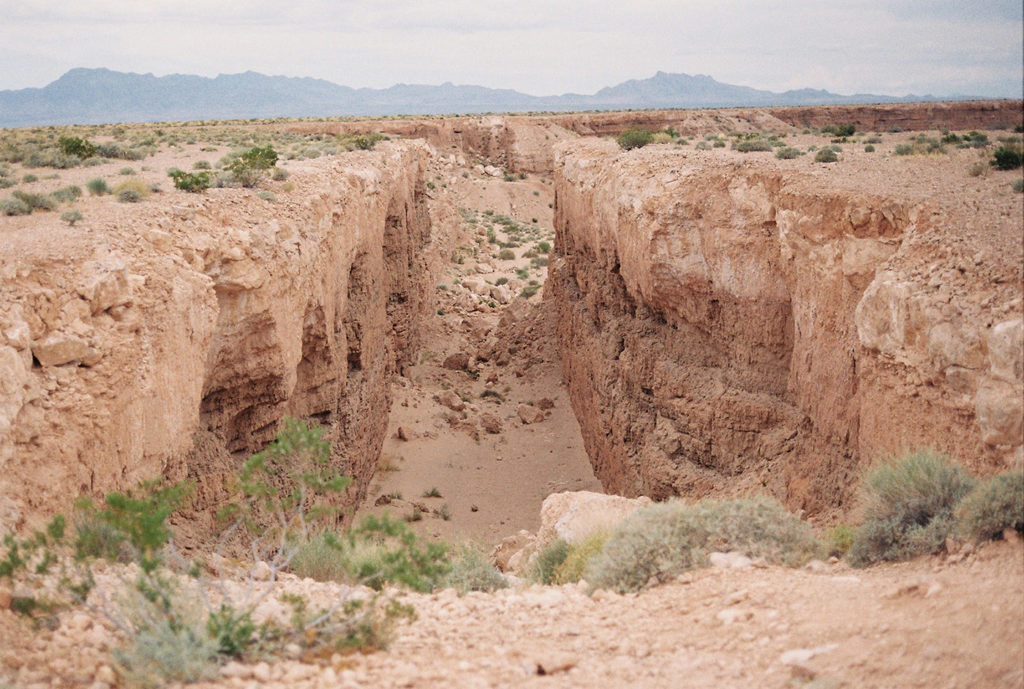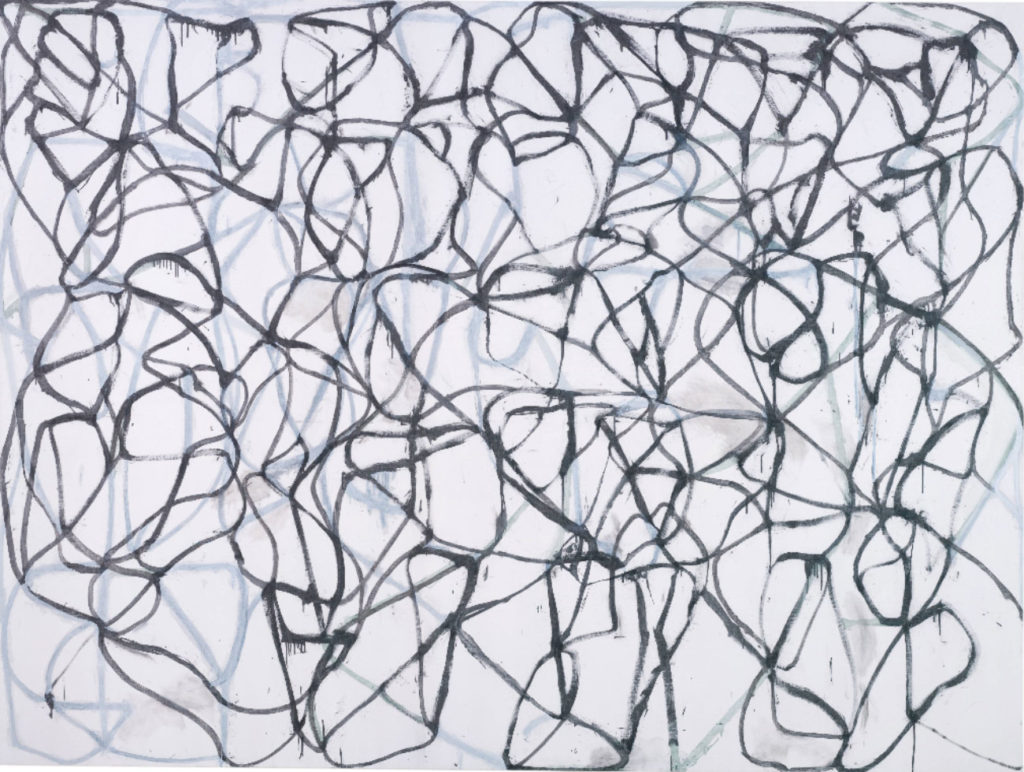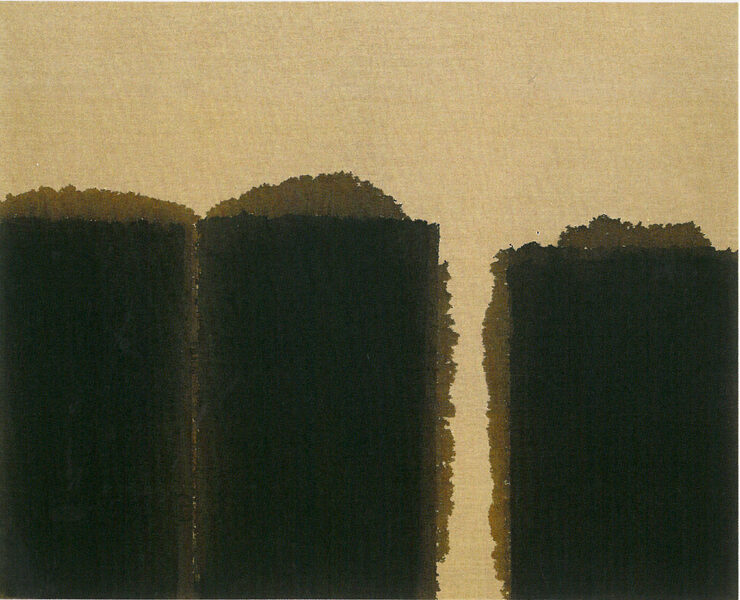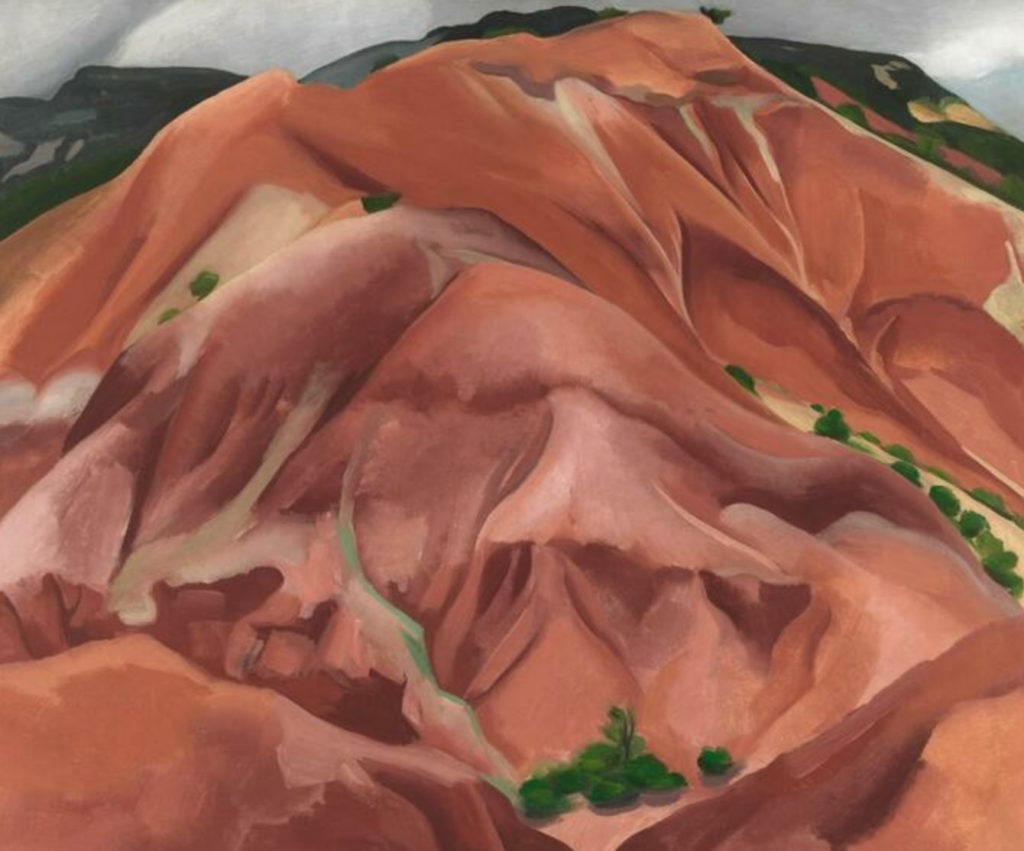From Hydra to Cold Mountain
히드라에서 한산까지
Text and Translation by Mimi Park 박상미

The work by Brice Marden that had genuinely caught my eye was the series Cold Mountain. In the early 1980s, he had traveled to Thailand, India, and Sri Lanka, and became interested in Asian landscape and culture. Since then, Marden came across the calligraphy of a poem by the Tang Dynasty Chinese poet-monk Han Shan(寒山), and he was deeply moved by his life, poems, and calligraphy (Cold Mountain is the translation of the Chinese characters for Han Shan:寒山). Inspired by the calligraphy, Marden created a series that conjures up the image of letters. Once he stated how it is hard to look at paintings: "You have to be able to bring all sorts of things together in your mind, your imagination, in your whole body … " When he would install his large sized works, the height of the canvas would match the viewer's height, in order to enhance the dynamics between his work and the viewer's body. His Cold Mountain series did just that; it felt as if I had met each painting with my physical presence.
I have always loved Chinese characters, ever since I was a child. They were like drawings to me. When you write them out, it feels like a composition is forming. In each character, a certain plasticity was there. When I learned English words by heart, it felt like memorizing signs, whereas for Chinese characters, it was like memorizing pictures. And I was good at it. After college, living in New York for years, I forgot a lot of Chinese characters that I used to know. From a certain point on, I found myself looking at them, rather than reading them. It was not pleasant to feel rather ignorant and illiterate, but the more I could see these characters as drawings, the more discernible the form was to my eyes. As the meaning became an image, the burden of meaning itself disappeared; only the concrete nature of the drawing remained. When I look at the characters like I would at drawings by Matisse or Picasso, I could enjoy looking at them even though I could not read them. Hence Brice Marden's Cold Mountain series amplified my 'joy of illiteracy' in a pictorial and spectacular manner.
Han Shan was a legendary monk-poet of the Tang Dynasty, presumed to be a figure of the 9th century. He lived in the premises of Guoqing Temple with monks Shide(拾得) and Fenggan(豊干), and they were called the "Three Recluses of Guoqing". Han Shan lived inside a cave and ate leftover rice and vegetables from the temple, and wore the same hemp clothes and clogs whether it was summer or winter. He would go around and write poems on trees and rocks. He was known to be a great thinker well-versed in Confucianism, Taoism, and Buddhism. An example of his poem:
吾心似秋月 My mind is like the autumn moon
碧潭淸皎潔 The blue pond is clear and clean
無物堪比倫 Nothing can compare with this
敎我如何說 How should I be told and educated otherwise?
From early on, Marden was interested in the rectangular form of the canvas and grids. When he was making sketches for Cold Mountain, he perceived the shape of the Chinese poem as a grid and began drawing each letter in the shape of an upside down conch. As in calligraphy, top to bottom, right to left. Without knowing each letter's sound or meaning, he had drawn the form of letters as if drawing a human body. He used sticks like Jackson Pollock did. Whereas Pollock used a stick to splatter paint, Marden attached a paintbrush to a stick longer than 60cm, and used it to paint. It was his intention to give up control of his agile hands and invite unexpected movements. He would paint on the canvas, and a thin white coat over the lines, then paint on them again, using the slightly visible drawings as a guide. Looped curves resembling Chinese characters untangle onto the canvas as if dancing. When they are linked to different forms, eyes follow them, and the freedom and sense of rhythm felt by the body are tremendous.
Pollock laid the canvas on the floor, and used sticks to splash paint while walking around the canvas. He was aware of the zen state of becoming one with his work. Pollock's method is evaluated as the event that overcame the Western dualistic idea of the mind/body. In fact, the expression "abstract art" has often been pointed out as an incorrect term in this regard. Such works where the materiality of the medium and the movement of the body are in harmony, are the most concrete types of paintings. Marden had transferred his interest in classical proportions and subtle color studies that he had delved into in Hydra onto an Asian landscape through the series Cold Mountain. In all the Asian calligraphy and paintings he observed, they embodied the subtle colors of nature he was immersed in. From the life of Han Shan who abandoned his desires for self, Marden gained the pictorial freedom of 'knowing myself is forgetting myself.' Drawing is the most intimate and direct way to create art, and the distance between the artist and the work is the narrowest in this state. Marden realized Eastern calligraphy through Western drawing, and thus developed it into a new type of painting. It explores the relationship between body and soul in the Western painting realm, and superimposes the 'rarefied state' of the air of the Aegean Sea, where Greek and Roman languages intersect onto an Asian space. Whenever his lines dance in a large parabolic curve, to meet and break up, the olive trees of Hydra and the autumn landscape cherished by Han Shan merge and then distance themselves. Indeed, what we see is a mystic encounter between the Mediterranean sky and the state of zen.
사이 톰블리를 얘기할 때 나폴리 연안 프로치다 섬이 생각나듯, 브라이스 마든에 관한 말할 때 그리스 에게 해 연안 히드라Hydra 섬을 빼놓을 수 없을 것이다. 일찌기 히드라 섬을 찬양했던 헨리 밀러의 말처럼, 이 섬은 사로니코스 만에 "딱딱하게 굳은 커다란 빵이 바다에 떠오르듯" 수평으로 길게 떠있는 섬이다. 마덴은 70년 대 초 이 섬을 방문한 후 그곳에 집을 샀고, 여기서 <그로브 그룹Grove Group> 연작을 시작했다. 올리브 나무들에 영감을 받아 시작한 이 모노크롬 시리즈는 이름 붙이기 힘든 색들로 이루어졌고, 어떤 은유나 상징도 표방하지 않는, '그림 그 자체'다. 마든은 히드라의 올리브 나무숲에 대해 "말할 수 없이 미묘한 은회색 빛이 감도는 녹색"이라고, 에게 해의 바다를 두고는 "청색, 회색, 황색, 유황색, 옥색, 황색, 청색"이라고 했다. 자연은 '리얼'하고, 자연이 주는 '리얼'한 정보를 토대로 제작한 그림들이라고 그는 말한다. 이 그림들은 길쭉한 캔버스들이 나란히 붙어 하나의 화면을 이루는데, 이 기다란 형태는 인체나 고대 건축물의 비례에서 온 것이라 한다. '리얼니스 realness'와 회화의 물질성, 신체성 등이 그의 주된 관심사로 자리 잡은 것은 지중해에서였다. 이름 붙이기 어려운, 올리브 나무와 에게 해의 미묘한 색깔들과 함께. 브라이스 마든이 나의 눈길을 제대로 끈 것은 <콜드마운틴 Cold Mountain> 연작을 통해서였다. 그는 80년대 초반 태국과 인도, 스리랑카 등을 여행했고 아시아의 풍경과 문화에 관심을 가지게 되었다. 이후 마든은 중국 당나라의 승려 시인 한산寒山의 시를 쓴 서예를 보았는데, 한산의 삶과 시, 그리고 글씨에 감동받게 된다.(Cold Mountain은 한산寒山의 번역이다) 그 영감으로 제작했다는 이 연작은 실제로 글씨를 연상시킨다. 마든은 언젠가 그림을 보는 일의 어려움에 관해 "머릿속에 들어 있는 모든 것을 총동원하고 상상력과 함께, 온몸으로 봐야한다"라고 말한 적이 있다. 그는 그림이 관객의 몸과 교감하게 하기 위해 대형 캔버스를 벽에 걸 때 캔버스의 중심을 사람의 명치와 일치되는 높이에 설치했다. 그의 콜드마운틴 연작이야말로 내 몸에 와서 부딪혔다고 해도 과언이 아닐 것이다.

나는 어려서부터 한자를 좋아했다. 한자는 일종의 그림이었다. 글씨를 쓸 때 형태를 구성하는 느낌을 주는 문자다. 영어 단어를 외울 때 기호를 외우는 느낌이라면 한자는 그림을 외우는 느낌이었다. 그리고 난 그림을 잘 외우는 편이었다. 대학에 들어가고, 미국에 가면서 한자를 많이 잊게 되었는데, 그래서 언제부터인가 나는 한자를 읽는 대신 보게 되었다. 무식한 까막눈이 된 것 같아 상쾌하지 않았지만, 한자의 글씨들이 드로잉으로 보이기 시작하면서 형태는 더욱 선명하게 눈에 들어왔다. 의미가 이미지가 되었고, 의미의 부담이 사라지면서 그림의 구체성만 남았다. 마티스나 피카소의 드로잉을 보듯 글씨를 보다보면, 읽지는 못하더라도 보는 일이 즐거워졌다. 브라이스 마덴의 <콜드마운틴> 시리즈는 나의 그 '까막눈의 즐거움'을 회화적으로, 스펙터클하게 증폭시킨 하나의 사건이었다. 한산은 9세기 경 인물로 추정되는 중국 당나라의 전설적인 승려 시인이다. 한산은 습득拾得과 풍간豊干 선사라는 도인들과 국청사國淸寺에 살았고, 이들은 국청사에 사는 은자들이라는 의미로 국청삼은國淸三隱이라 불렸다. 한산은 굴속에서 살며 남들이 먹다 남긴 밥과 나물을 먹었고 여름 겨울없이 베옷과 나막신을 신고 다니며 나무나 바위 이곳저곳에 시를 썼다고 한다. 한산은 유교, 도교, 불교에 모두 정통했던 도인이라 알려졌다. 예를 들면 이런 시가 있다.
吾心似秋月 (오심사추월) 나의 마음은 가을 달과 같으니
碧潭淸皎潔 (벽담청교결) 푸른 연못은 맑고도 깨끗하네
無物堪比倫 (무물감비륜) 아무 것도 이에 비할 수 없으니
敎我如何說 (교아여하설) 나에게 어떻게 말하여 가르치는가
브라이스 마든은 초기부터 캔버스의 직사각형 형태와 그리드에 관심이 있었다. 마든은 <콜드마운틴> 연작을 위한 스케치를 할 무렵 한시가 쓰인 모양을 그리드로 파악하고 각 글자를 소라가 뒤집어진 모양으로 그려나갔다. 서예처럼 위에서 아래로, 오른쪽에서 왼쪽으로 그렸다. 각 글자의 음과 훈이 무엇인지 모르는 채 마치 인체를 드로잉 하듯 글자들의 형태를 그린 것이다. 그는 잭슨 폴록이 했던 것처럼 막대기를 이용했다. 폴록이 막대기로 물감을 뿌렸다면 마덴은 60cm이상 긴 막대기에 붓을 묶어 그렸다. 능숙한 손의 컨트롤을 포기하고 예기치 못한 움직임을 들여놓겠다는 의도이다. 한 번 그리고 나서 다시 얇게 흰 칠을 하고 흰 칠 밑으로 살며시 보이는 드로잉에 의거하여 그 위에 또 그렸다. 애초 한자를 닮았던 '폐곡선' 같은 선들이 캔버스 전면으로 춤추듯 풀려 나가며 다른 형태들과 연결될 때, 눈이 따르며 몸으로 느끼는 자유로움과 리듬감은 엄청나다.
잭슨 폴록은 캔버스를 바닥에 깔아놓고 캔버스 주위를 돌며 막대기로 물감을 흩뿌리는 방식으로 작업했고, 물아일체의 선적 경지에 대해 인식하고 있었다. 폴록의 이러한 작업 방식은 실제로 서양의 정신/신체라는 이원론적 사고방식을 극복한 이벤트로 평가된다. 사실 추상미술이라는 명칭은 이런 점에서 잘못된 명명이라 종종 지적되어 왔다. 재료의 물질성과 몸의 움직임이 어우러진 이 작품들이야말로 회화 중에서도 가장 구체적인 종류이기 때문이다. 브라이스 마든은 히드라 섬에서 천착하던 고전적 비례와 이름할 수 없는 미묘한 색감에 대한 관심을 <콜드마운틴> 연작을 통해 동양적 풍경 속으로 옮겨놓았다. 그가 본 동양의 글씨와 그림에서 모두 그가 몰입하던 자연의 미묘한 색이 구현되어 있었고, 자아의 욕망을 버리고 살아가는 한산의 삶에서 "나를 아는 것은 나를 잊는 것이다"라는 회화적 자유를 얻었다. 드로잉이야말로 가장 친밀하고 직접적인 예술의 제작 방식이고, 예술가와 작품 사이의 거리가 가장 좁혀진 상태이다. 마덴은 동양의 서예를 서양의 드로잉으로 구현하며 새로운 회화로 발전시켰다. 서양 회화의 현장에서 몸과 영혼의 관계를 탐색하며, 그리스 로마의 언어가 교차하는 에게 해의 공기의 '희박함'을 동양의 공간에 겹쳐놓은 것이다. 그의 선이 춤추듯 큰 포물선을 그리며만나고 헤어질 때 히드라의 올리브 나무들과 한산이 보던 가을의 풍경이 이어졌다가는 또 멀어진다. 지중해적 공간과 선적 공간의 만남이 신비롭다. (6. 2015)
Mimi Park
Writer, Translator/
Creative Director at CLUMSY and TPNY
박상미
작가, 번역가/
클럼지, TPNY의 크리에이티브 디렉터

RELATED POSTS
